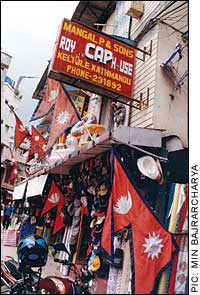 Right up there with Mt Everest, there is one thing that makes Nepal stand out in the community of nations, and that is our unique national flag.
Right up there with Mt Everest, there is one thing that makes Nepal stand out in the community of nations, and that is our unique national flag. While everyone else is a bland rectangle, we have a triangle-and two of them! In many an international conference, organisers don't know what to do with the Nepal flag and put it in a background white rectangle so it "fits" with the rest.
Back home in Nepal, the flag is not accorded the respect it deserves. The US prohibits the burning of the flag. The UK is known for its distinctive Union Jack-patterned boxer shorts. In Nepal, well, no one really knows what to do with the flag or even whether to do anything with it.

Sure, tourists in Thamel, buy them for their exotic value, and have them sewn onto backpacks and caps. Santa Bahadur Tamang, a shopkeeper in Thamel, fondly remembers the 1999 SAARC football final when young Nepalis bought out his stock of flags, but that's about it.
 The flag is largely ignored here, even by institutions that ought to know better. The singha on top of Singha Darbar holds a flag proudly, but the crimson is often faded to an off-pink.
The flag is largely ignored here, even by institutions that ought to know better. The singha on top of Singha Darbar holds a flag proudly, but the crimson is often faded to an off-pink. Sarisiddhi's Shahid Smarak School hoists a tattered, discoloured national flag in its front yard every day. Principal Badri Prasad Khanal, like so many other people in the capital and outside, does not know that there are strict, specific rules in Nepal on flag etiquette (see box).
Schools, for instance are not allowed to raise the rato ra chandra surya. The Education Act does allow them to hoist it if celebrating a national event, but the flag must be taken down when the ceremony is over. so the national anthem is sung sans flag in school all over Nepal.
Then there are those who are officially allowed to carry the flag: ministers, high officials, royal Nepali ambassadors abroad, the Nepali merchant marine has even made it a "flag of convenience" even though we are landlocked. Royal Nepal Airlines flew the flag on the tail fins of its aircraft, but dumped it for the generic German-designed red and blue stripe. Necon Air took the innovative step to stick a waving Nepali flag on its fuselage, and got into trouble in the beginning because it wasn't the "official" flag carrier.
Professor Daya Ram Shrestha, who won the Madan Puraskar in 1997 for his research on the Nepali national flag, doesn't think the situation is so dire. "Sure, there are small signs of neglect here and there, but by and large we Nepali people respect our flag."
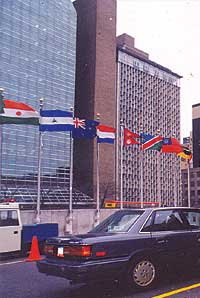 In his book Nepal ko Rastriya Jhanda , Professor Shrestha tracks the development of the Nepali flag from when it was first used by Lichchhavi king Mandev some 1,500 years ago. King Mandev and others who followed him chose the Vedic emblem as their flag, and that is the origin of the unique double triangle.
In his book Nepal ko Rastriya Jhanda , Professor Shrestha tracks the development of the Nepali flag from when it was first used by Lichchhavi king Mandev some 1,500 years ago. King Mandev and others who followed him chose the Vedic emblem as their flag, and that is the origin of the unique double triangle. The one we use now dates from the unification of Nepal by Prithvi Narayan Shah, though the border at that time was green, rather than blue. Of course, it was much later, in the 1963 constitution, that the flag was officially declared the national emblem, though the double triangle had already been hoisted at the United Nations headquarters in New York when Nepal acquired membership in December 1955.
According to Shrestha, the crimson is supposed to signify the blood shed by brave Nepalis of yore who safeguarded our independence. The sun is a symbol of the Nepali soul, the moon signifies the Nepali mind. The blue border is the Himalayan sky and portays the immensity of the universe of which we are a part.
Oddly enough, given its uniqueness and its symbolism, the 1958 constitution totally overlooked the need to recognise the banner as the national flag.
We might not actively carry out acts of violence or disrespect, but look around any time you're out and about, and you'll see any number of limp, sad looking flags where they shouldn't be. The general post office in Sundhara is not constitutionally entitled to hoist a national flag, but ask insiders about its odd practice of flying one all the time and you get a resigned shrug and explanations of "tradition". Is it tradition to fly a flag that look like a hurricane
just hit it?
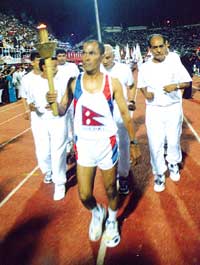 Even government offices that can legally raise the flag do it in such a manner as to nullify any uplifting effects the sight of the national emblem is supposed to have. The important thing about the flag is that it is a deeply symbolic object, not just an identifying sticker in the long parade of nations. The other important thing about the flag is that, no matter how much of a mess the rest of the country might look like, a good flag is at the very least a sign of striving, an indication that at least we aspire to better things.
Even government offices that can legally raise the flag do it in such a manner as to nullify any uplifting effects the sight of the national emblem is supposed to have. The important thing about the flag is that it is a deeply symbolic object, not just an identifying sticker in the long parade of nations. The other important thing about the flag is that, no matter how much of a mess the rest of the country might look like, a good flag is at the very least a sign of striving, an indication that at least we aspire to better things. So if the flag policy, which Nepal enacted in April 1992, strictly outlines the procedures to be followed during hoisting of a flag, it is generally a good idea to follow them. For example, flags raised on office buildings should be hoisted within five minutes of sunrise and folded before sunset. On occasions when the flags are required to be hoisted after sunset, it should be hoisted under spotlight. The same goes with the flags on vehicles. In US the national flags are folded even during cloudy days. And the Swiss need no greater excuse than a bright sunny day to fly the flag from every restaurant, inn, or cheese factory in the confederation.
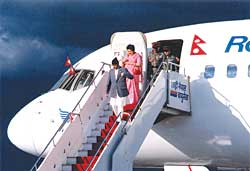 Drive through Maitighar to Putali Sadak, and there shines the Health Ministry's flag under the light of the full moon. It's a sign of the times that flags on ministry buildings look tatty and discoloured even though the flag policy requires that the minute a flag shows any signs of damage, it needs to be replaced. Ke garne? Yo Nepal ho.
Drive through Maitighar to Putali Sadak, and there shines the Health Ministry's flag under the light of the full moon. It's a sign of the times that flags on ministry buildings look tatty and discoloured even though the flag policy requires that the minute a flag shows any signs of damage, it needs to be replaced. Ke garne? Yo Nepal ho. It might just help if Nepali flags were made out of the strong bunting fabric used in other parts of the world rather than the delicate and/ or flimsy silks, cottons and polyesters.
Damaged or not, flags hoisted on government buildings need to be changed every Dasain and Chaite Dasain, by law. It makes sense, and not just because they are so conveniently six months apart-these festivals are fundamentally for the worship of shakti (power), the concept symbolised by the triangles in the Nepali flags. That's even more argument for treating the flag with respect-it actually speaks to an integral part of Nepali national identity, unlike the national symbols of a number of other countries that were simply invented because 'everyone has one, so bring on the trite colours of valour and honesty' and let's just stack them atop each other'.
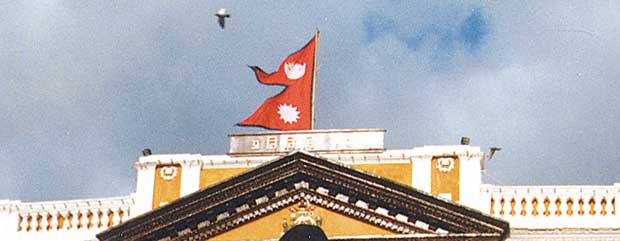
Who can hoist a Nepali flag?
According to the 1992 policy:
. Members of the general public can hoist the national flag in their private homes and offices to celebrate the coronation of a king and his birthday, and to mark national unity day and democracy day.
. The prime minister, chief justice, speaker of the House of Representatives, chairs of the upper house and the Royal Council, and chiefs of diplomatic missions may display a flag on their official residence, vehicle and office.
. A 1959 government directive allows the ministers to hoist the flag on their official vehicles while commuting to and from official ceremonies.
. In 1992, the deputy prime minister, deputy speaker of the House of Representatives, assistant ministers and the deputy chair of the Upper House were given permission to affix the flag to their official vehicles for official ceremonies.


